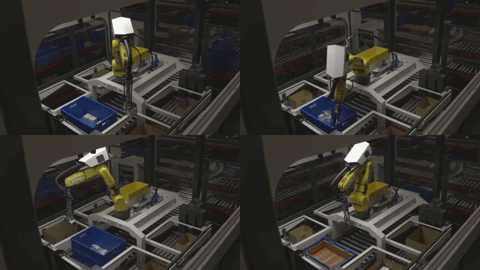This is what the latest generation of robotics companies like Covariant and Osaro specialize in, a technology that didn’t become commercially viable until late 2019. Right now such robots are most skilled at simple manipulation tasks, like picking up objects and placing them in boxes, but both startups are already working with customers on more complicated sequences of motions, including auto-bagging, which requires robots to work with crinkly, flimsy, or translucent materials. Within a few years, any task that previously required hands to perform could be partially or fully automated away.
Some companies have already begun redesigning their warehouses to better capitalize on these new capabilities. Knapp, for example, is changing its floor layout and the way it routes goods to factor in which type of worker—robot or human—is better at handling different products. For objects that still stump robots, like a net bag of marbles or delicate pottery, a central routing algorithm would send them to a station with human pickers. More common items, like household goods and school supplies, would go to a station with robots.
Derik Pridmore, cofounder and CEO at Osaro, predicts that in industries like fashion, fully automated warehouses could come online within two years, since clothing is relatively easy for robots to handle.
That doesn’t mean all warehouses will soon be automated. There are millions of them around the world, says Michael Chui, a partner at the McKinsey Global Institute who studies the impact of information technologies on the economy. “Retrofitting all of those facilities can’t happen overnight,” he says.

Nonetheless, the latest automation push raises questions about the impact on jobs and workers.
Previous waves of automation have given researchers more data about what to expect. A recent study that analyzed the impact of automation at the firm level for the first time found that companies that adopted robots ahead of others in their industry became more competitive and grew more, which led them to hire more workers. “Any job loss comes from companies who did not adopt robots,” says Lynn Wu, a professor at Wharton who coauthored the paper. “They lose their competitiveness and then lay off workers.”
But as workers at Amazon and FedEx have already seen, jobs for humans will be different. Roles like packing boxes and bags will be displaced, while new ones will appear—some directly related to maintaining and supervising the robots, others from the second-order effects of fulfilling more orders, which would require expanded logistics and delivery operations. In other words, middle-skilled labor will disappear in favor of low- and high-skilled work, says Wu: “We’re breaking the career ladder, and hollowing out the middle.”
But rather than attempt to stop the trend of automation, experts say, it’s better to focus on easing the transition by helping workers reskill and creating new opportunities for career growth. “Because of aging, there are a number of countries in the world where the size of the workforce is decreasing already,” says Chui. “Half of our economic growth has come from more people working over the past 50 years, and that’s going to go away. So there’s a real imperative to increase productivity, and these technologies can help.
“We also just need to make sure that the workers can share the benefits.”





Recent Comments